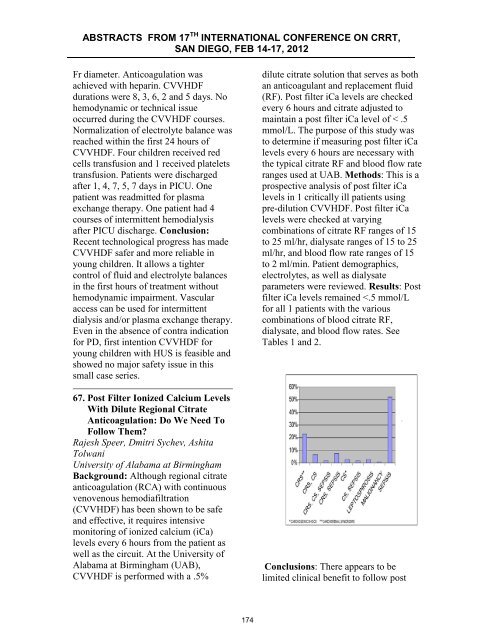ABSTRACTS from 16th International COnference on ... - CRRT Online
ABSTRACTS from 16th International COnference on ... - CRRT Online
ABSTRACTS from 16th International COnference on ... - CRRT Online
You also want an ePaper? Increase the reach of your titles
YUMPU automatically turns print PDFs into web optimized ePapers that Google loves.
<str<strong>on</strong>g>ABSTRACTS</str<strong>on</strong>g> FROM 17 TH INTERNATIONAL CONFERENCE ON <strong>CRRT</strong>,<br />
SAN DIEGO, FEB 14-17, 2012<br />
Fr diameter. Anticoagulati<strong>on</strong> was<br />
achieved with heparin. CVVHDF<br />
durati<strong>on</strong>s were 8, 3, 6, 2 and 5 days. No<br />
hemodynamic or technical issue<br />
occurred during the CVVHDF courses.<br />
Normalizati<strong>on</strong> of electrolyte balance was<br />
reached within the first 24 hours of<br />
CVVHDF. Four children received red<br />
cells transfusi<strong>on</strong> and 1 received platelets<br />
transfusi<strong>on</strong>. Patients were discharged<br />
after 1, 4, 7, 5, 7 days in PICU. One<br />
patient was readmitted for plasma<br />
exchange therapy. One patient had 4<br />
courses of intermittent hemodialysis<br />
after PICU discharge. C<strong>on</strong>clusi<strong>on</strong>:<br />
Recent technological progress has made<br />
CVVHDF safer and more reliable in<br />
young children. It allows a tighter<br />
c<strong>on</strong>trol of fluid and electrolyte balances<br />
in the first hours of treatment without<br />
hemodynamic impairment. Vascular<br />
access can be used for intermittent<br />
dialysis and/or plasma exchange therapy.<br />
Even in the absence of c<strong>on</strong>tra indicati<strong>on</strong><br />
for PD, first intenti<strong>on</strong> CVVHDF for<br />
young children with HUS is feasible and<br />
showed no major safety issue in this<br />
small case series.<br />
67. Post Filter I<strong>on</strong>ized Calcium Levels<br />
With Dilute Regi<strong>on</strong>al Citrate<br />
Anticoagulati<strong>on</strong>: Do We Need To<br />
Follow Them?<br />
Rajesh Speer, Dmitri Sychev, Ashita<br />
Tolwani<br />
University of Alabama at Birmingham<br />
Background: Although regi<strong>on</strong>al citrate<br />
anticoagulati<strong>on</strong> (RCA) with c<strong>on</strong>tinuous<br />
venovenous hemodiafiltrati<strong>on</strong><br />
(CVVHDF) has been shown to be safe<br />
and effective, it requires intensive<br />
m<strong>on</strong>itoring of i<strong>on</strong>ized calcium (iCa)<br />
levels every 6 hours <str<strong>on</strong>g>from</str<strong>on</strong>g> the patient as<br />
well as the circuit. At the University of<br />
Alabama at Birmingham (UAB),<br />
CVVHDF is performed with a .5%<br />
dilute citrate soluti<strong>on</strong> that serves as both<br />
an anticoagulant and replacement fluid<br />
(RF). Post filter iCa levels are checked<br />
every 6 hours and citrate adjusted to<br />
maintain a post filter iCa level of < .5<br />
mmol/L. The purpose of this study was<br />
to determine if measuring post filter iCa<br />
levels every 6 hours are necessary with<br />
the typical citrate RF and blood flow rate<br />
ranges used at UAB. Methods: This is a<br />
prospective analysis of post filter iCa<br />
levels in 1 critically ill patients using<br />
pre-diluti<strong>on</strong> CVVHDF. Post filter iCa<br />
levels were checked at varying<br />
combinati<strong>on</strong>s of citrate RF ranges of 15<br />
to 25 ml/hr, dialysate ranges of 15 to 25<br />
ml/hr, and blood flow rate ranges of 15<br />
to 2 ml/min. Patient demographics,<br />
electrolytes, as well as dialysate<br />
parameters were reviewed. Results: Post<br />
filter iCa levels remained
















